Piezoelectric Elements with PVDF–TrFE/MWCNT-Aligned Composite Nanowires for Energy Harvesting Applications
Abstract
:1. Introduction
2. Experimental Section
3. Results and Discussion
4. Conclusions
Author Contributions
Funding
Data Availability Statement
Acknowledgments
Conflicts of Interest
References
- Wang, L.; Fei, Z.; Wu, Z.; Ye, Y.; Qi, Y.; Wang, J.; Zhao, L.; Zhang, C.; Zhang, Y.; Qin, G.; et al. Wearable bending wireless sensing with autonomous wake-up by piezoelectric and triboelectric hybrid nanogenerator. Nano Energy 2023, 112, 108504. [Google Scholar] [CrossRef]
- Sun, Y.; Li, Y.-Z.; Yuan, M. Requirements, challenges, and novel ideas for wearables on power supply and energy harvesting. Nano Energy 2023, 115, 108715. [Google Scholar] [CrossRef]
- Hou, J.; Qian, S.; Hou, X.; Zhang, J.; Wu, H.; Guo, Y.; Xian, S.; Geng, W.; Mu, J.; He, J.; et al. A high-performance mini-generator with average power of 2 W for human motion energy harvesting and wearable electronics applications. Energy Convers. Manag. 2023, 277, 116612. [Google Scholar] [CrossRef]
- Divya, S.; Oh, T.H.; Bodaghi, M. 1D nanomaterial based piezoelectric nanogenerators for self-powered biocompatible energy harvesters. Eur. Polym. J. 2023, 197, 112363. [Google Scholar] [CrossRef]
- Rashmi, M.R.; Sairam, K.T.; Suresh, A. Energy harvesting through piezoelectric technology. Mater. Today Proc. 2023. [Google Scholar] [CrossRef]
- Xue, H.; Jiang, L.; Lu, G.; Wu, J. Multilevel Structure Engineered Lead-Free Piezoceramics Enabling Breakthrough in Energy Harvesting Performance for Bioelectronics. Adv. Funct. Mater. 2023, 33, 2212110. [Google Scholar] [CrossRef]
- Rodrigues-Marinho, T.; Correia, V.; Tubio, C.-R.; Ares-Pernas, A.; Abad, M.-J.; Lanceros-Méndez, S.; Costa, P. Flexible thermoelectric energy harvesting system based on polymer composites. Chem. Eng. J. 2023, 473, 145297. [Google Scholar] [CrossRef]
- Xie, Z.; Shi, K.; Song, L.; Hou, X. Experimental and Field Study of a Pavement Thermoelectric Energy Harvesting System Based on the Seebeck Effect. J. Electron. Mater. 2023, 52, 209–218. [Google Scholar] [CrossRef]
- Nan, Y.; Wang, X.; Xin, S.; Xu, H.; Niu, J.; Ren, M.; Yu, T.; Huang, Y.; Hou, B. Designed a hollow Ni2P/TiO2 S-scheme heterojunction for remarkably enhanced photoelectric effect for solar energy harvesting and conversion. J. Mater. Chem. C 2023, 11, 4576–4587. [Google Scholar] [CrossRef]
- Li, F.; Peng, W.; Wang, Y.; Xue, M.; He, Y. Pyro-Phototronic Effect for Advanced Photodetectors and Novel Light Energy Harvesting. Nanomaterials 2023, 13, 1336. [Google Scholar] [CrossRef]
- Feng, Z.; Zhao, Z.; Liu, Y.; Liu, Y.; Cao, X.; Yu, D.-G.; Wang, K. Piezoelectric Effect Polyvinylidene Fluoride (PVDF): From Energy Harvester to Smart Skin and Electronic Textiles. Adv. Mater. Technol. 2023, 8, 2300021. [Google Scholar] [CrossRef]
- Yan, D.; Wang, J.; Xiang, J.; Xing, Y.; Shao, L.-H. A flexoelectricity-enabled ultrahigh piezoelectric effect of a polymeric composite foam as a strain-gradient electric generator. Sci. Adv. 2023, 9, eadc8845. [Google Scholar] [CrossRef] [PubMed]
- Duan, Q.; Peng, W.; He, J.; Zhang, Z.; Wu, Z.; Zhang, Y.; Wang, S.; Nie, S. Rational Design of Advanced Triboelectric Materials for Energy Harvesting and Emerging Applications. Small Methods 2023, 7, 2201251. [Google Scholar] [CrossRef] [PubMed]
- Zhang, R.; Hummelgård, M.; Örtegren, J.; Andersson, H.; Olsen, M.; Chen, W.; Wang, P.; Dahlström, C.; Eivazi, A.; Norgren, M. Energy Harvesting Using Wastepaper-Based Triboelectric Nanogenerators. Adv. Eng. Mater. 2023, 25, 2300107. [Google Scholar] [CrossRef]
- Chakhchaoui, N.; Farhan, R.; Boutaldat, M.; Rouway, M.; Eddiai, A.; Meddad, M.; Hajjaji, A.; Cherkaoui, O.; Boughaleb, Y.; Van Langenhove, L. Piezoelectric β-polymorph formation of new textiles by surface modification with coating process based on interfacial interaction on the conformational variation of poly (vinylidene fluoride) (PVDF) chains. Eur. Phys. J. Appl. Phys. 2020, 91, 31301. [Google Scholar] [CrossRef]
- Guo, J.; Nie, M.; Wang, Q. Self-Poling Polyvinylidene Fluoride-Based Piezoelectric Energy Harvester Featuring Highly Oriented β-Phase Structured at Multiple Scales. ACS Sustain. Chem. Eng. 2021, 9, 499–509. [Google Scholar] [CrossRef]
- He, Z.; Rault, F.; Lewandowski, M.; Mohsenzadeh, E.; Salaün, F. Electrospun PVDF Nanofibers for Piezoelectric Applications: A Review of the Influence of Electrospinning Parameters on the β Phase and Crystallinity Enhancement. Polymers 2021, 13, 174. [Google Scholar] [CrossRef]
- Chandran, A.M.; Varun, S.; Mural, P.K.S. Development of self-poled PVDF/MWNT flexible nanocomposites with a boosted electroactive β-phase. New J. Chem. 2020, 44, 14578–14591. [Google Scholar] [CrossRef]
- Sekine, T.; Ito, K.; Shouji, Y.; Suga, R.; Yasuda, T.; Wang, Y.-F.; Takeda, Y.; Kumaki, D.; Dos Santos, F.D.; Tong, H.; et al. Robotic e-skin for high performance stretchable acceleration sensor via combinations of novel soft and functional polymers. Appl. Mater. Today 2023, 33, 101877. [Google Scholar] [CrossRef]
- Sun, L.L.; Li, B.; Zhang, Z.G.; Zhongb, W.H. Achieving Very High Fraction of β-Crystal PVDF and PVDF/CNF Composites and Their Effect on AC Conductivity and Microstructure through A Stretching Process. Eur. Polym. J. 2010, 46, 2112–2119. [Google Scholar] [CrossRef]
- Wu, A.Y.; Kong, J.; Zhang, C.; Liu, T.; Kotaki, M.; Lu, X. Polymorphism of Electrospun Polyvinylidene Difluoride/Carbon Nanotube (CNT) Nanocomposites: Synergistic Effects of CNT Surface Chemistry, Extensional Force and Supercritical Carbon Dioxide Treatment. Polymer 2012, 53, 5097–5102. [Google Scholar]
- Ahn, Y.; Lim, J.Y.; Hong, S.M.; Lee, J.; Ha, J.; Choi, H.J.; Seo, Y. Enhanced Piezoelectric Properties of Electrospun Poly(vinylidene fluoride)/Multiwalled Carbon Nanotube Composites Due to High β-Phase Formation in Poly(vinylidene fluoride). J. Phys. Chem. C 2013, 117, 11791–11799. [Google Scholar] [CrossRef]
- Ryu, M.; Hong, Y.-K.; Lee, S.-Y.; Park, J.H. Ultrahigh loading dry-process for solvent-free lithium-ion battery electrode fabrication. Nat. Commun. 2023, 14, 1316. [Google Scholar] [CrossRef]
- Mishra, S.; Kumaran, K.; Sivakumaran, R.; Pandian, S.P.; Kundu, S. Synthesis of PVDF/CNT and their functionalized composites for studying their electrical properties to analyze their applicability in actuation & sensing. Colloids Surf. A Physicochem. Eng. Asp. 2016, 509, 684–696. [Google Scholar]
- Han, J.; Kim, D.B.; Kim, J.H.; Kim, S.W.; Ahn, B.U.; Cho, Y.S. Origin of high piezoelectricity in carbon nanotube/halide nanocrystal/P(VDF-TrFE) composite nanofibers designed for bending-energy harvesters and pressure sensors. Nano Energy 2022, 99, 107421. [Google Scholar] [CrossRef]
- Lin, X.; Yu, F.; Zhang, X.; Li, W.; Zhao, Y.; Fei, X.; Li, Q.; Yang, C.; Huang, S. Wearable Piezoelectric Films Based on MWCNT-BaTiO3/PVDF Composites for Energy Harvesting, Sensing, and Localization. ACS Appl. Nano Mater. 2023, 6, 11955–11965. [Google Scholar] [CrossRef]
- Kumar, A.; Jaiswal, S.; Joshi, R.; Yadav, S.; Dubey, A.; Sharma, D.; Lahiri, D.; Lahiri, I. Energy harvesting by piezoelectric polyvinylidene fluoride/zinc oxide/carbon nanotubes composite under cyclic uniaxial tensile deformation. Polym. Compos. 2023, 44, 4746–4756. [Google Scholar] [CrossRef]
- Uddin, A.S.M.I.; Lee, D.; Cho, C.; Kim, B. Impact of Multi-Walled CNT Incorporation on Dielectric Properties of PVDF-BaTiO3 Nanocomposites and Their Energy Harvesting Possibilities. Coatings 2022, 12, 77. [Google Scholar] [CrossRef]
- Levi, N.; Czerw, R.; Xing, S.; Preethi Iyer, A.; Carroll, D.L. Properties of Polyvinylidene Difluoride−Carbon, Nanotube Blends. Nano Lett. 2004, 4, 1267–1271. [Google Scholar] [CrossRef]
- Xu, D.; Zhang, H.; Pu, L.; Li, L. Fabrication of Poly(vinylidene fluoride)/Multiwalled carbon nanotube nanocomposite foam via supercritical fluid carbon dioxide: Synergistic enhancement of piezoelectric and mechanical properties. Compos. Sci. Technol. 2020, 192, 108108. [Google Scholar] [CrossRef]
- Tsanev, T.; Aleksandrova, M.; Videkov, V. Study of nanoporous anodic aluminum oxide as a template filled with piezoelectric materials. In Proceedings of the 31st IEEE International Conference on Microelectronics, MIEL 2019, Nish, Serbia, 16–18 September 2019; pp. 125–128. [Google Scholar]
- Aleksandrova, M.P.; Tsanev, T.D.; Pandiev, I.M.; Dobrikov, G.H. Study of piezoelectric behaviour of sputtered KNbO3 nanocoatings for flexible energy harvesting. Energy 2020, 205, 118068. [Google Scholar] [CrossRef]
- Aleksandrova, M.; Tsanev, T.; Gupta, A.; Singh, A.K.; Dobrikov, G.; Videkov, V. Sensing Ability of Ferroelectric Oxide Nanowires Grown in Templates of Nanopores. Materials 2020, 13, 1777. [Google Scholar] [CrossRef] [PubMed]
- Hatakeyama, T.; Kibushi, R.; Ishizuka, M.; Tomimura, T. Fundamental study of surface roughness dependence of thermal and electrical contact resistance. In Proceedings of the 2016 15th IEEE Intersociety Conference on Thermal and Thermomechanical Phenomena in Electronic Systems (ITherm), Las Vegas, NV, USA, 31 May–3 June 2016; pp. 1078–1082. [Google Scholar]
- Qamar, Z.; Zakria, M.; Shakoor, R.I.; Raffi, M.; Mehmood, M.; Mahmood, A. Reinforcement of electroactive characteristics in polyvinylidene fluoride electrospun nanofibers by intercalation of multi-walled carbon nanotubes. J. Polym. Res. 2017, 24, 39. [Google Scholar] [CrossRef]
- Park, D.H.; Kan, T.G.; Lee, Y.K.; Kim, W.N. Effect of multi-walled carbon nanotube dispersion on the electrical and rheological properties of poly(propylene carbonate)/poly(lactic acid)/multi-walled carbon nanotube composites. J. Mater. Sci. 2013, 48, 481–488. [Google Scholar] [CrossRef]
- Aleksandrova, M. Spray deposition of piezoelectric polymer on plastic substrate for vibrational harvesting and force sensing applications. AIMS Mater. Sci. 2018, 5, 1214–1222. [Google Scholar] [CrossRef]
- Milone, G.; Tulliani, J.-M.; Al-Tabbaa, A. PVDF-based coatings with CNT additions for strain monitoring of mortar substrates subjected to bending. MATEC Web Conf. 2023, 378, 05001. [Google Scholar] [CrossRef]
- Bankova, A.; Videkov, V.; Tzaneva, B.; Mitov, M.; Potiron, S.; Molinari, M. Nanoindentation study of the mechanical properties and deformation behavior of nanoporous alumina films. J. Phys. Conf. Ser. 2020, 1492, 012020. [Google Scholar] [CrossRef]
- Wang, A.; Hu, M.; Zhou, L.; Qiang, X. Self-Powered Wearable Pressure Sensors with Enhanced Piezoelectric Properties of Aligned P(VDF-TrFE)/MWCNT Composites for Monitoring Human Physiological and Muscle Motion Signs. Nanomaterials 2018, 8, 1021. [Google Scholar] [CrossRef]

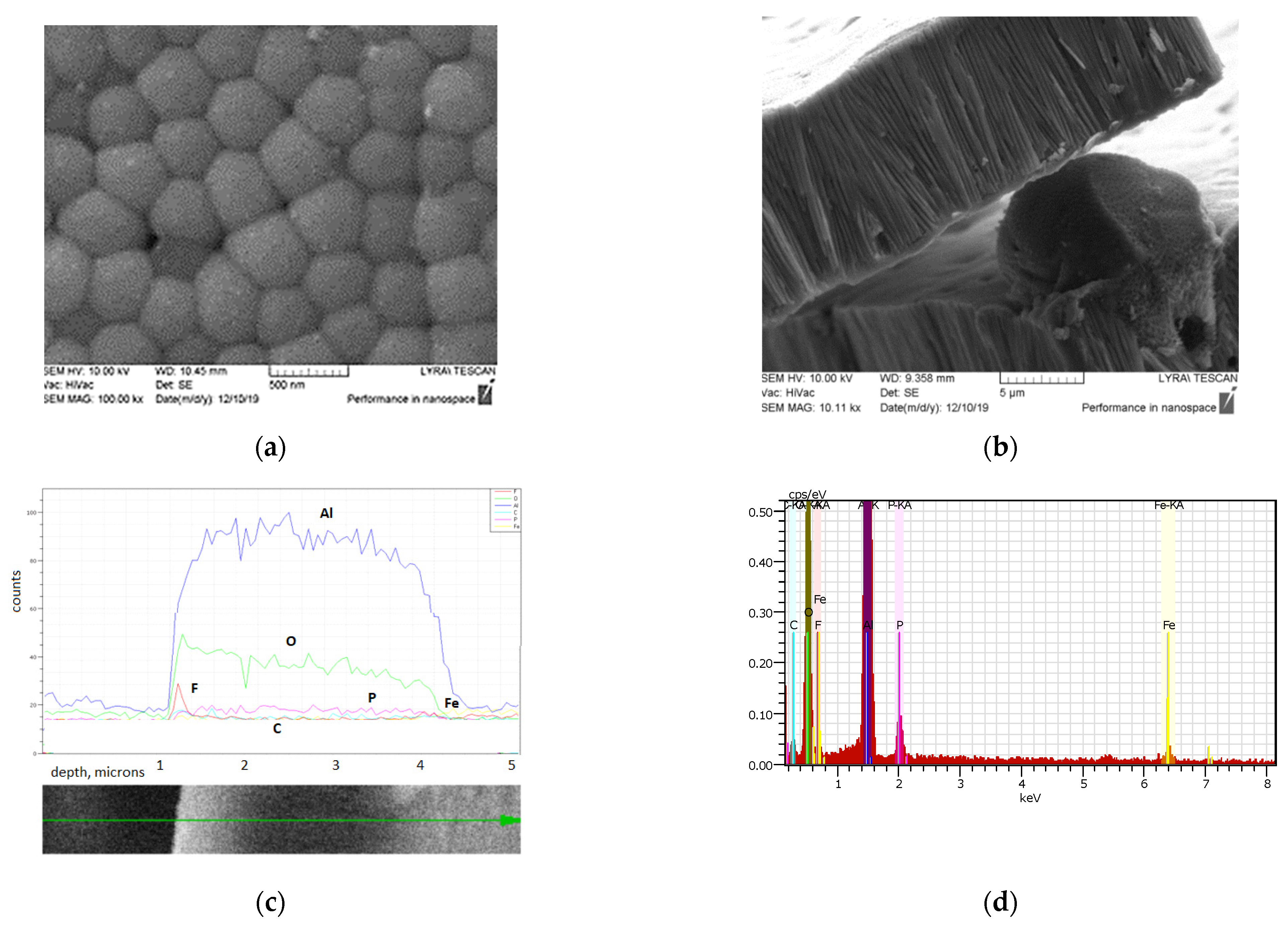

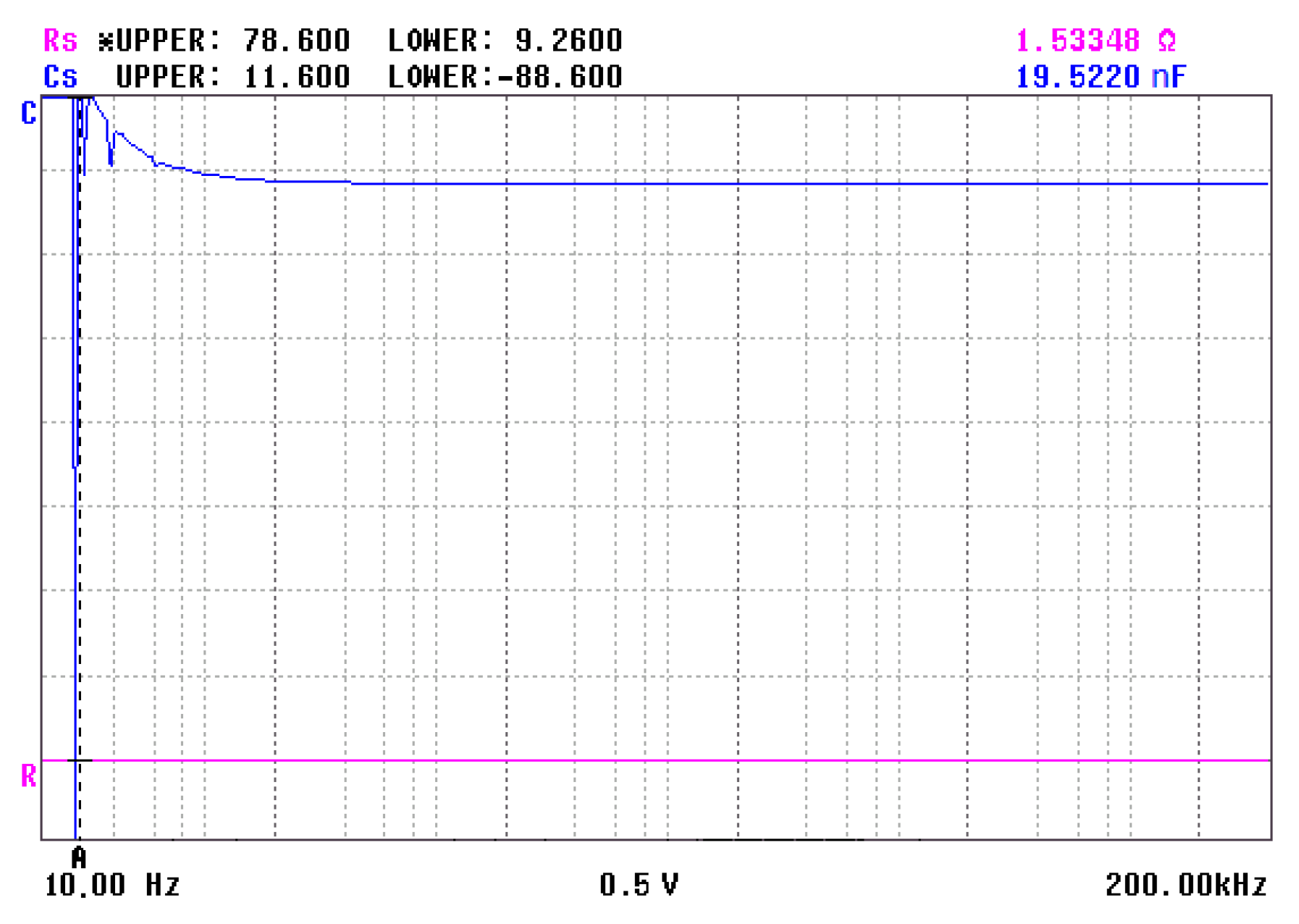
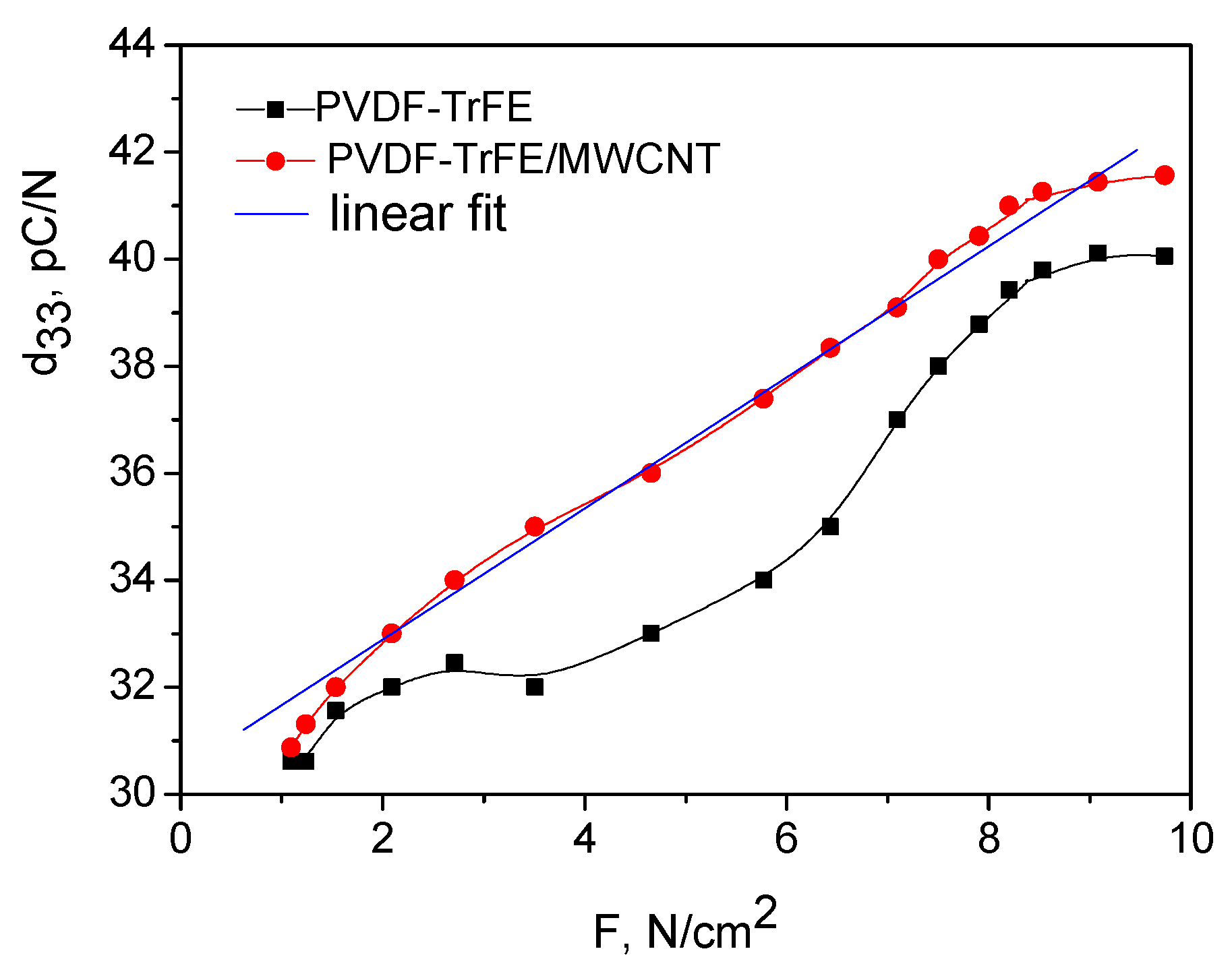
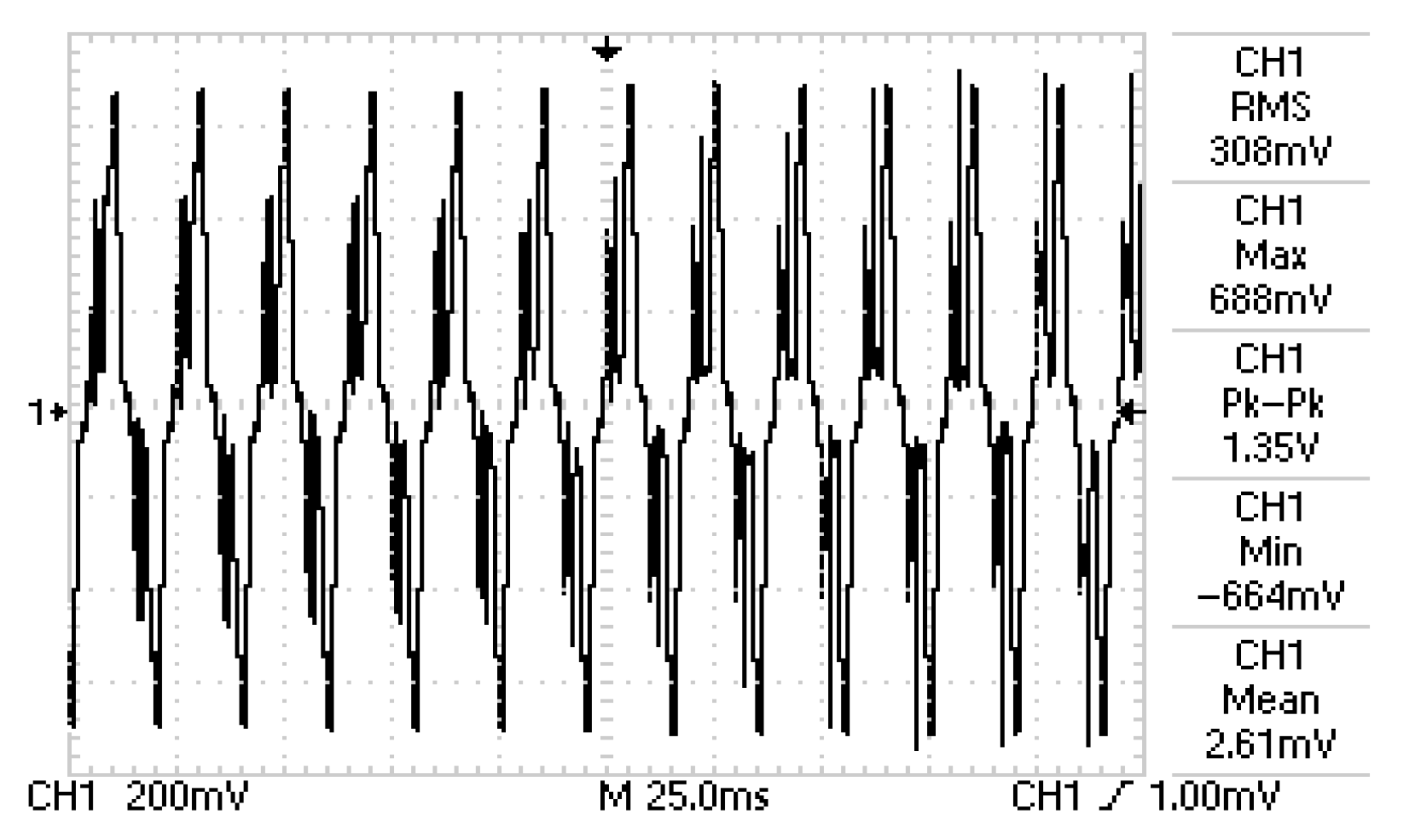
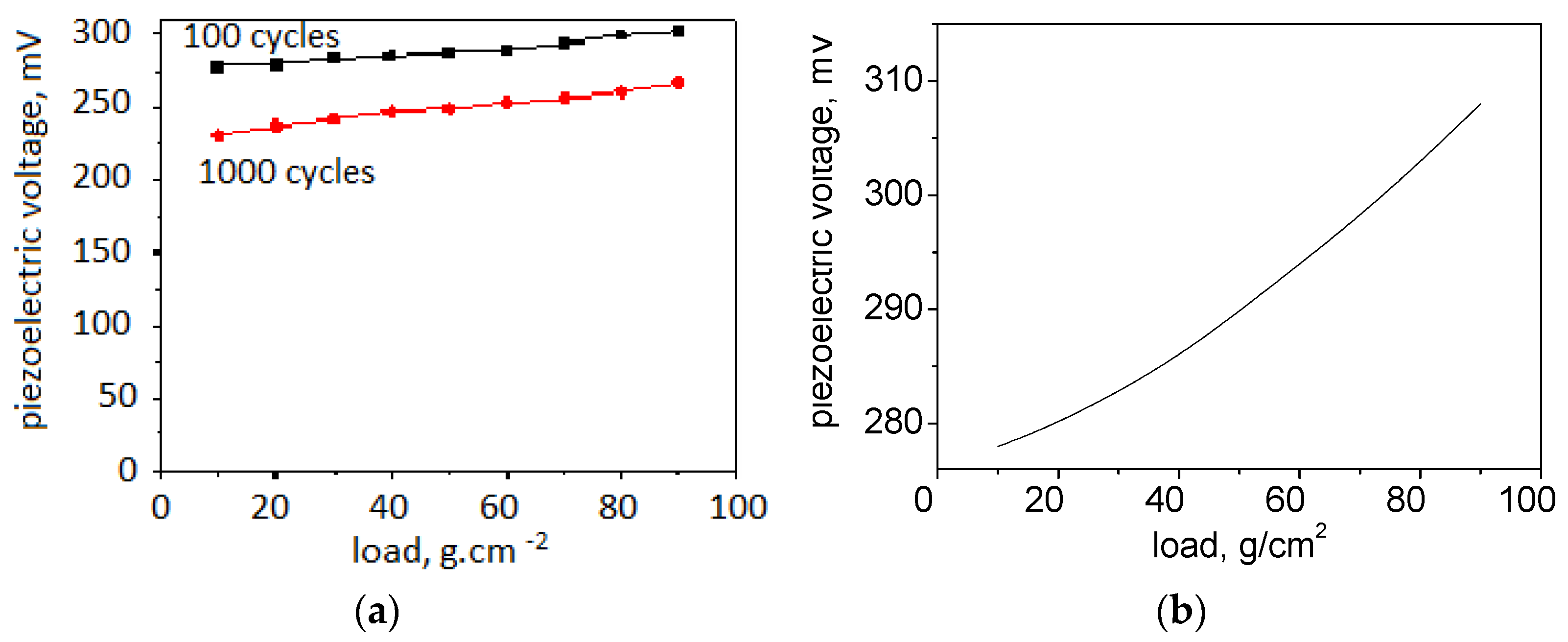
Disclaimer/Publisher’s Note: The statements, opinions and data contained in all publications are solely those of the individual author(s) and contributor(s) and not of MDPI and/or the editor(s). MDPI and/or the editor(s) disclaim responsibility for any injury to people or property resulting from any ideas, methods, instructions or products referred to in the content. |
© 2023 by the authors. Licensee MDPI, Basel, Switzerland. This article is an open access article distributed under the terms and conditions of the Creative Commons Attribution (CC BY) license (https://creativecommons.org/licenses/by/4.0/).
Share and Cite
Aleksandrova, M.; Tsanev, T.; Kadikoff, B.; Alexandrov, D.; Nedelchev, K.; Kralov, I. Piezoelectric Elements with PVDF–TrFE/MWCNT-Aligned Composite Nanowires for Energy Harvesting Applications. Crystals 2023, 13, 1626. https://doi.org/10.3390/cryst13121626
Aleksandrova M, Tsanev T, Kadikoff B, Alexandrov D, Nedelchev K, Kralov I. Piezoelectric Elements with PVDF–TrFE/MWCNT-Aligned Composite Nanowires for Energy Harvesting Applications. Crystals. 2023; 13(12):1626. https://doi.org/10.3390/cryst13121626
Chicago/Turabian StyleAleksandrova, Mariya, Tsvetozar Tsanev, Berek Kadikoff, Dimiter Alexandrov, Krasimir Nedelchev, and Ivan Kralov. 2023. "Piezoelectric Elements with PVDF–TrFE/MWCNT-Aligned Composite Nanowires for Energy Harvesting Applications" Crystals 13, no. 12: 1626. https://doi.org/10.3390/cryst13121626





